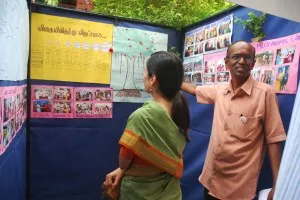[TC-I Changemakers] Tara Thiagarajan of Madura Micro Finance - II

This is the second part of a two-part interview of Dr. Tara Thiagarajan Madura Micro Finance, a company providing microfinance as well as knowledge and market opportunities through its microeducation and micromarkets products to 400,000 women in rural Tamil Nadu. The first part of this interview can be read hereIn one of your articles in your weblog The Physics of Poverty you have talked about The Madura Experiment involving smartphones and network analysis platforms to help your borrower network better. Can you please provide more insights on how this experiment works and where has this reached till now?
After decades of microfinance, we’ve seen that it is not effective in driving anything more than incremental change within the same subsistence paradigm and we have spent time trying to understand why – why microfinance borrowers are not able to make a leap in their thinking and apply it innovatively to achieve larger scale. The hypothesis we are working on, based on several years of observation, dipstick research and insights from academia is that this is because the rural communities (where we work and where most of India’s poverty is concentrated) are a very fragmented network where information and products spread very slowly, if at all.
Our goal is therefore to apply cutting edge scientific analysis to understanding the network structure and dynamics as well as its evolution and then use this to make strategic product interventions that drive faster flow of information, ideas and goods. For instance we could identify and drive links between specific communities that would collapse the average path length in the system and result in a many-fold change in the probability that a good idea gets from one place to another. We will also contribute to scientific understanding of the relationship between network position and demographic outcome. And last but not least, we will have an incredibly sophisticated understanding of our member base that will allow us to segment our market very effectively and put a lot of intelligence into our new product development and approach.
We are currently in the process of setting it up – training our staff, building the back end and establishing research collaborations. By the end of October 500 of our field staff will be out there collecting massive amounts of data about our member demographics, connectivity and behaviour on an ongoing basis. We have embedded all the research questions in fast easy chunks as part of our overall loan proposal and repayment process. For instance, the cashier at the branch office spends 2 minutes asking each of the women who come to remit money three or four questions before giving them the receipt. Each of our branch offices has a throughput of 300 to 600 women per month.
As a scientist with a background in network analysis and a deep interest in understanding complex systems, this is extremely exciting for me. The systems I have worked with are networks of neurons but there is a lot of overlap in the analytical frameworks. We will do some of the analysis in-house, but given the enormous magnitude of data, we are bringing together a consortium of cutting edge social network researchers, mainly in the US, and giving them access to the data to look at various aspects.
How was feature film “Shakti Pirakkudu” received? Were you able to see a positive impact on the way the viewers conduct their business?
We originally conceived this as a training film specifically designed for the mini-MBA. The director Usha Rajeswari who has worked with us on all our earlier training

films had a burst of inspiration and just wrote a script for a complete feature. It was just an amazing script so she finally convinced us this was the way to go.We’ve tested reaction to the film and recall and it’s been amazing. It’s barely out of the studio so it hasn’t been out long enough for us to know how it’s impacted their approach to business. That will take time.
You can read more about it and follow reactions on our website at www.shaktirising.in and also on facebook at http://www.facebook.com/pages/Shakti-Pirakkudhu/159566044062442 and twitter @ShaktiPirakkudhu
Is the movie for public viewing soon to hit the theatres or it is exclusively made for your borrowers? If the common man wants to see it how can he see it?
It’s made for a general audience and will show around rural Tamil Nadu. We are working toward an English subtitled release for the urban audience at select screens in Chennai and perhaps other cities. No date has been set yet. In the US the premier screening will be at SALTAF – the South Asian Literary and Theatre Arts Festival (www.saltaf.org) – at the Smithsonian in Washington DC on Nov 13. We are also entering it in various film festivals and will have other by-invitation screenings in various cities in collaboration with other organizations. Eventually the film will become available for purchase on DVD.
What was your initial reaction when hearing SKS’ plans to go public and how has that changed after their apparent success in their IPO? Do you feel as though this is a good direction for MFIs to head or does it deviate from their original missions? [Ref: http://tinyurl.com/353mrod]
An IPO is a good way to access capital and any sort of scale needs capital, so it doesn’t surprise me at all that SKS or any other MFI would consider it. On the other hand when an IPO becomes more about exit for early investors it can create all sorts of pressures, particularly on growth and valuations.
One of the negative repercussions in the industry clambering for rapid growth and faster IPO are that field staff are given extremely aggressive targets and incentives. This has turned microfinance in India into a push rather than pull process with hard selling and minimal borrower selection criteria in the race to meet targets. I’m uncomfortable with that. I think an impacting microfinance has to be discriminating.
It’s important for people to exercise good judgement in how they approach an IPO and not just get caught up in the glamour of the game and the numbers.
Given the credit crisis, the term securitization has developed a bad name. However, MFIs are now looking to this model to help regularize their sources of capital and apportion risk. Where do you stand on this issue and why?[Ref: http://tinyurl.com/3xekhvc]
I think securitization can be a useful tool if used the right way. Unfortunately very often the risk assessment that goes into this is not based on real understanding of risk. The people who ‘value’ the risk rarely have any context for the borrowers and their circumstances.






